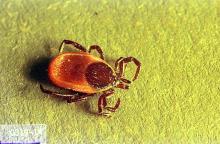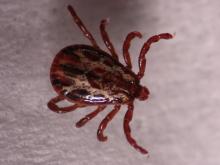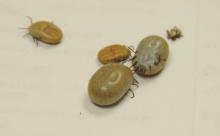Dermacentor spp.
Ixodes spp.
Ornithodoros spp.
Pest description and damage Ticks are blood-feeding ectoparasites. Some transmit disease to humans.
Management
Keep grassy and weedy areas trimmed to reduce harbor for tick hosts. Tick populations on a property can be evaluated by dragging a white cloth through vegetation. Ticks will attach to the cloth and can be seen easily against the white background. The reservoir tick host, which carries Lyme disease, is the white-footed mouse (deer mouse). Several products are available that attract mice to feeding stations where they may be treated with an insecticide.
Ticks attached to humans or pets should be removed promptly. Remove ticks immediately by grasping between thumb and index finger and pulling straight out. Do not twist. Wash area with soap and water. Apply antibiotic ointment. Watch for any redness or swelling. If irritation persists, contact a physician. Repellents containing diethyl toluamide (DEET) are effective; use the lowest effective concentration-usually less than 30% DEET. Follow label instructions carefully. Around the outside of the home, tick populations can be reduced by using residual insecticides. Follow label instructions. For tick control on pets, consult a veterinarian.
See also:
For further information:
Ticks. Washington State Department of Health. https://www.doh.wa.gov/CommunityandEnvironment/Pests/Ticks





